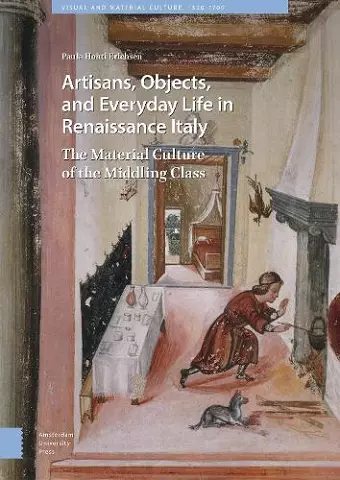Artisans, Objects and Everyday Life in Renaissance Italy
The Material Culture of the Middling Class
Format:Hardback
Publisher:Amsterdam University Press
Published:25th Nov '20
Currently unavailable, and unfortunately no date known when it will be back

Did ordinary Italians have a ‘Renaissance’? This book presents the first in-depth exploration of how artisans and small local traders experienced the material and cultural Renaissance. Drawing on a rich blend of sixteenth-century visual and archival evidence, it examines how individuals and families at artisanal levels (such as shoemakers, barbers, bakers and innkeepers) lived and worked, managed their household economies and consumption, socialised in their homes, and engaged with the arts and the markets for luxury goods. It demonstrates that although the economic and social status of local craftsmen and traders was relatively low, their material possessions show how these men and women who rarely make it into the history books were fully engaged with contemporary culture, cultural customs and the urban way of life.
Winner of the 2021 Roland H. Bainton Book Prize for Art and Music History, awarded by Sixteenth Century Society & Conference (SCSC) for the best book in the field of Art and Music History!
"This is a well written, detailed, and profusely illustrated, discussion of middle class Italian Renaissance household possessions mainly at Siena, although there are examples from other parts of Italy, in the fifteenth and sixteenth centuries, the period largely before the Siena was conquered by Florence in 1555–57. The illustrations are striking. [...] A useful book for anyone needing to identify objects in Renaissance literature or works of art."
- R. Burr Litchfield, Seventeenth-Century News, Vol. 79 3&4 (2021)
"In this thoughtful and well-written book, Erichsen illuminates the material culture of what she calls "the middling class," artisans and shopkeepers in Siena, who occupied a social and economic level above the poor and wage laborers and below the prosperous elites. [...] The downwardly mobile, the sick, the damaged, and the poor do not often appear in the sources intended to find and tax the strivers or to enable inheritance. Erichsen’s comprehensive view of rich and neglected sources has brought new people into the study of Renaissance life."
- Steven A. Epstein, Journal of Interdisciplinary History, Volume 52, Number 2, Autumn 2021
"This fine book is deeply expert. Its author has worked many years in Siena’s archives, studying the city’s material culture. At the heart of her research are the household inventories, systematic documents, often post-mortem, that went from room to room, laying out in precise detail the objects in each space. [...] The book, thorough and astute, is nicely on top of current scholarship on Renaissance Italian material culture. The meticulous notes very often give the original Italian, a precision very useful to scholars, who will want to check Sienese terminology for things or attributes. The illustrations, all in colour, are plentiful, and carefully captioned: they feature surviving artefacts, and their depiction in works of art, and also show the documents on which the argument rests."
- Thomas V Cohen, Journal of Design History, York University, Toronto, 2021
ISBN: 9789463722629
Dimensions: unknown
Weight: unknown
364 pages